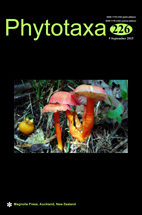Abstract
Erythroxylum Browne (1756: 278) is the largest genus in Erythroxylaceae Kunth (1821: 175), including 230–240 species (Plowman & Berry 1999, Plowman & Hensold 2004). It is distributed in tropical areas, with its greatest diversity (187 species) in the Neotropics (Plowman & Hensold 2004). The Neotropical species are characterized by intrapetiolar stipules, branchlets usually formed by the compression of cataphylls (brachyblasts), alternate, simple, and glabrous leaves, heterostylous flowers, often arranged in fascicles, and drupes with one pyrene (Plowman & Berry 1999). For Brazil 127 species of Erythroxylum have been recorded, with most of the diversity and endemism in the Atlantic Forest, especially in its northeastern section (Loiola & Costa-Lima 2015).

